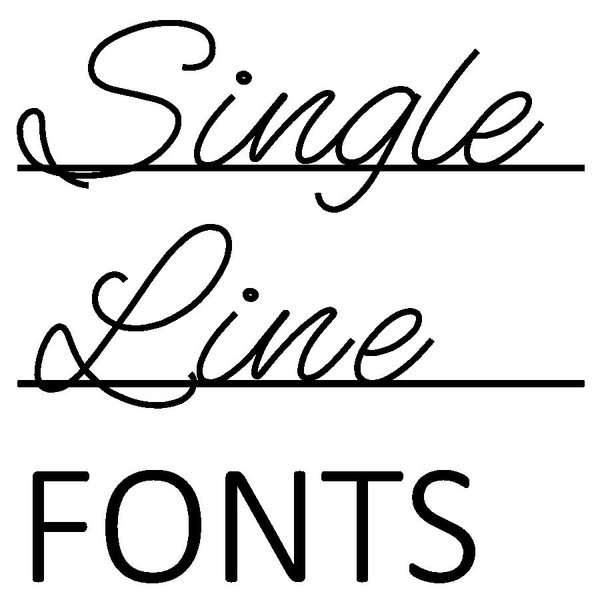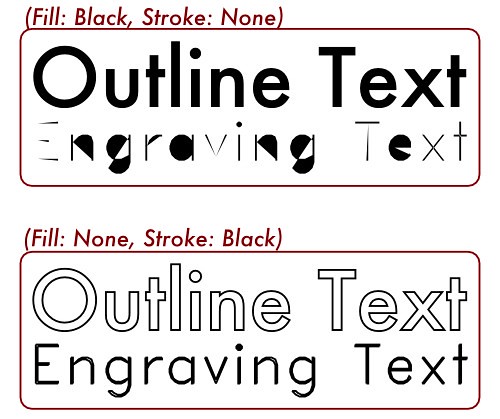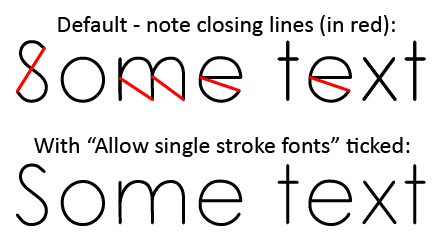Unveiling the Power of Single-Line Fonts in Valentina

In the world of digital design and manufacturing, single-line fonts, also known as engraving fonts, technical lettering fonts, or pen plotter fonts, have emerged as an essential tool for a specific purpose. These fonts diverge from the traditional outline or fill fonts, as they are designed with a single continuous line. Widely employed in CNC machining, laser cutting, and pen plotters, these fonts offer unique benefits that set them apart from their traditional counterparts.
A Glimpse into the World of Single-Line Fonts
The Role of Pen Plotters
While the concept of single-line fonts might seem niche, their utility shines in the realm of pen plotters. Unlike regular printers, pen plotters employ a pen to create images through a series of precisely calculated movements. This method can lead to an issue when working with traditional outline fonts, which are designed to be filled vector shapes. When rendered on a pen plotter, these fonts result in the outline being traced twice, leading to inefficiencies.
The Visual Difference

A visual comparison of text written in an outline font versus an engraving font illustrates the disparity. An outline font renders as expected on screen but presents issues when used with a pen plotter. Instead of a single-line representation, the pen plotter traces the outline, resulting in two boundaries. This creates not only visual inconsistencies but also slows down the printing process significantly.
Addressing Tool Size
In physical fabrication processes, tool size plays a crucial role. Whether it’s the pen width of a plotter, cutter width for a milling machine, or thread width for embroidery, the tool’s dimensions impact the outcome. Single-line engraving fonts are tailored to the tool’s width, ensuring legibility and accuracy. Unlike traditional outline fonts, which might require tracing the outline and potentially leading to distorted characters, engraving fonts rely on the tool’s width for character creation.
The Evolution and Implementation
The Historical Context
The concept of simplified representations of text is not new. In the early days of computer graphics, these fonts were essential for vector displays and pen plotters. However, the advent of outline fonts, dot matrix monitors, and high-resolution printers gradually shifted the focus away from single-line fonts.
Resurgence in the Modern Era
Today, with the accessibility of computer-controlled manufacturing tools like laser engravers, 3D printers, CNC routers, and pen plotters, the need for efficient text representation has resurfaced. Single-line fonts have found renewed relevance, catering to the requirements of these tools. Despite their significance, many design and illustration software lack support for engraving fonts due to their specialized nature.
Valentina’s Approach
While integrating support for single-line fonts presents challenges, the Valentina project acknowledges the need for this capability. The project explored various solutions, including the Hershey fonts—a renowned set of engraving fonts developed in the 1960s. However, the project decided to adopt SVG font format due to its compatibility with modern font editors and design tools. The SVG font format offers a standardized approach, enabling designers to edit existing fonts or create new ones seamlessly.
Navigating the Single-Line Font Experience in Valentina
Understanding True Single-Line Fonts
Before diving into the realm of single-line fonts in Valentina, it’s essential to distinguish authentic single-line fonts from outline fonts that might mimic the engraving style. Genuine single-line fonts are constructed with continuous paths, with certain glyphs possibly remaining open. This characteristic has a direct impact on how these fonts are rendered, demanding careful attention to avoid unusual connections in the final output.
Activating and Customizing Single-Line Fonts
Valentina has streamlined the integration of single-line fonts, ensuring a user-friendly experience. By activating the “Use single-line fonts” option found in the menu path File > Preferences > Pattern > Font, users can seamlessly transition to this font style. To facilitate this transition, Valentina scans specified folders to identify fonts that are compatible with the single-line rendering requirement. This approach offers users a versatile selection of fonts to cater to their specific needs and preferences.
Addressing Challenges: Rendering Broken Outline Fonts
While single-line SVG fonts are often the preferred choice due to their clarity and compatibility, we acknowledges that certain situations may necessitate rendering engraving fonts based on traditional outline fonts. To address this scenario, we introduces a practical workaround—allowing users to create instruction files that guide the rendering process for “broken” outline fonts.
Instruction Files for Accurate Rendering
Valentina’s innovative approach empowers users to create instruction files that provide specific guidance on how outline fonts should be rendered as single-line fonts. These instruction files play a crucial role in ensuring accurate and optimal rendering, especially when dealing with outline fonts that exhibit irregularities when adapted to a single-line format.
Simplifying the Process
Creating instruction files is a straightforward process that enhances the flexibility of Valentina’s single-line font rendering capabilities. Users can generate an instruction file for a font by following these steps:
- Install the appropriate font in your system.
- Restart Valentina to allow the application to recognize the font.
- Select the font from the available list.
- Activate the “Allow single stroke outline fonts” option.
- Access the menu option Pattern piece > Export font corrections to save the instruction file in JSON format.
- Edit the JSON file using a plain text editor to customize the rendering instructions for each character.
The Power of Instruction Files

Instruction files empower users to fine-tune how Valentina interprets and renders outline fonts as single-line fonts. By including details about which paths to retain or omit, users can optimize the output to align with their requirements. This adaptable solution bridges the gap between traditional outline fonts and the specialized needs of single-line rendering.
Conclusion
Single-line fonts are a testament to the marriage of traditional craftsmanship and modern technology. As digital design and manufacturing tools continue to evolve, these fonts find their place in an array of applications, from laser engraving to CNC machining. Valentina’s pursuit of integrating single-line font support underscores its commitment to serving the needs of its users, even in specialized domains. The journey to support these fonts highlights the project’s dedication to enhancing the toolset and offering versatile solutions that adapt to the changing landscape of design and fabrication.
Comments
No comments yet.